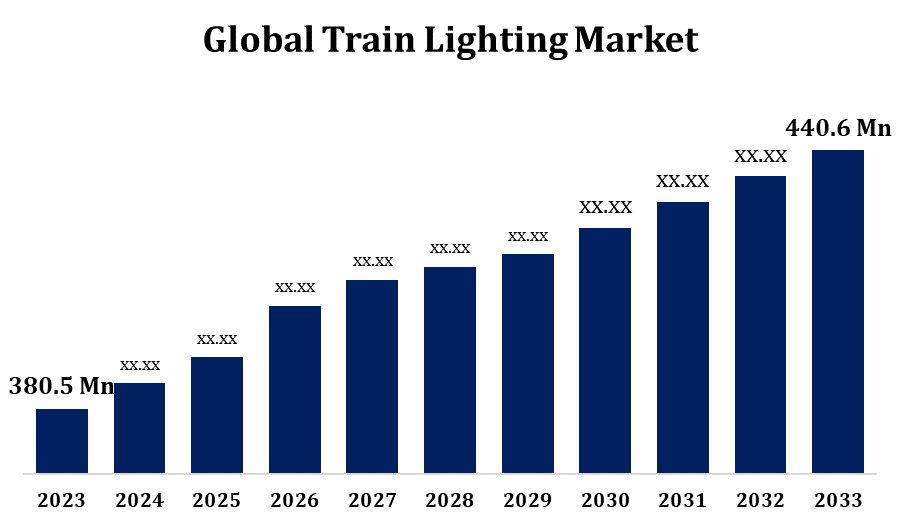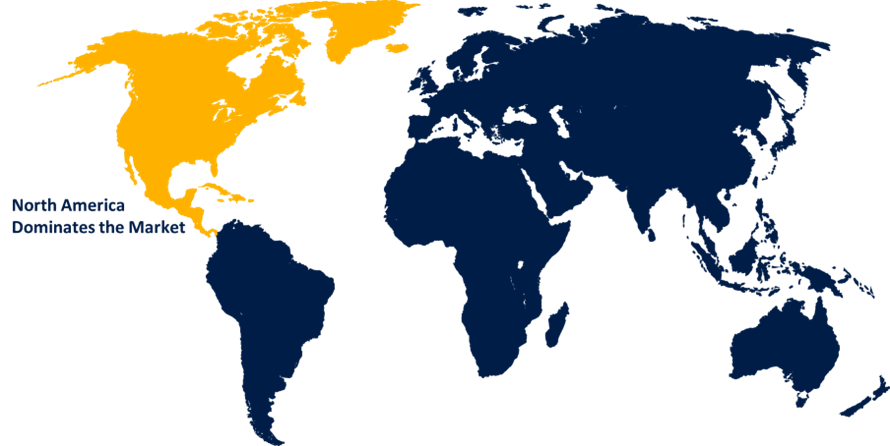Global Train Lighting Market Size, Share, and COVID-19 Impact Analysis, By Light Type (Fluorescent, Halogen, LED), By Position (Interior, Exterior), By Rolling Stock (Diesel, Electric, DMU), and By Region (North America, Europe, Asia-Pacific, Latin America, Middle East, and Africa), Analysis and Forecast 2023 - 2033
Industry: Automotive & TransportationGlobal Train Lighting Market Insights Forecasts to 2033
- The Train Lighting Market was valued at USD 380.5 Million in 2023.
- The market is growing at a CAGR of 1.48% from 2023 to 2033.
- The global Train Lighting Market Size is Expected to reach USD 440.6 Million by 2033.
- Asia Pacific is expected to grow the fastest during the forecast period.

Get more details on this report -
The Global Train Lighting Market Size is Expected to reach USD 440.6 Million By 2033, at a CAGR of 1.48% during the forecast period 2023 to 2033.
The train lighting market is experiencing steady growth, driven by the rising demand for energy-efficient and aesthetically pleasing lighting solutions in modern rail transport. As railway networks expand globally, particularly in emerging economies, the need for advanced lighting systems such as LED and smart lighting has increased to enhance passenger comfort, safety, and operational efficiency. Governments and transit authorities are investing in upgrading aging rail infrastructure, which further boosts market demand. Technological innovations, including automatic lighting controls and integration with passenger information systems, are also contributing to market expansion. Additionally, sustainability goals are pushing manufacturers to develop eco-friendly and durable lighting products. Key market players are focusing on innovation and customization to meet diverse regional requirements, making the train lighting market dynamic and competitive across both urban transit and long-distance railway segments.
Train Lighting Market Value Chain Analysis
The train lighting market value chain comprises several key stages, starting with raw material suppliers who provide essential components like LEDs, lenses, housings, and control systems. These materials are then utilized by lighting manufacturers to design and assemble various lighting products, including ambient, emergency, and exterior lights. System integrators play a crucial role by incorporating these lighting solutions into complete train systems, ensuring compatibility with electrical and control frameworks. OEMs (Original Equipment Manufacturers) then install these systems into new trains or retrofitted carriages. Distributors and dealers handle the supply chain logistics, delivering products to railway operators and maintenance service providers. End-users railway companies and transit authorities are responsible for installation, operation, and maintenance. Throughout the chain, quality control, innovation, and compliance with safety and energy regulations are essential for value delivery.
Train Lighting Market Opportunity Analysis
The train lighting market presents substantial opportunities fueled by technological advancements, sustainability initiatives, and infrastructure development. The integration of smart lighting systems, incorporating IoT and automation, enables real-time monitoring and adaptive illumination, enhancing energy efficiency and passenger comfort. The widespread adoption of LED technology offers benefits such as reduced energy consumption, lower maintenance costs, and longer lifespans, making it an attractive option for railway operators. Emerging markets, particularly in Asia-Pacific and Africa, are investing heavily in railway infrastructure, creating demand for modern and efficient lighting solutions. Additionally, the focus on retrofitting existing trains with advanced lighting systems provides opportunities for manufacturers to offer customized solutions that align with safety and environmental standards. These factors collectively position the train lighting market for significant growth and innovation in the coming years.
Global Train Lighting Market Report Coverage
| Report Coverage | Details |
|---|---|
| Base Year: | 2023 |
| Market Size in 2023: | USD 380.5 Million |
| Forecast Period: | 2023-2033 |
| Forecast Period CAGR 2023-2033 : | 1.48% |
| 2033 Value Projection: | USD 440.6 Million |
| Historical Data for: | 2019-2022 |
| No. of Pages: | 240 |
| Tables, Charts & Figures: | 98 |
| Segments covered: | By Light Type, By Position, By Region and COVID-19 Impact Analysis |
| Companies covered:: | Toshiba Corporation, General Electric, Hitachi, Ltd., Federal-Mogul Corporation, Koito Manufacturing Co., Ltd., Grupo Antolin, Osram Licht AG, Teknoware, Dräxlmaier Group, Autolite Ltd. and other key vendors. |
| Pitfalls & Challenges: | COVID-19 Empact, Challenge, Future, Growth, & Analysis |
Get more details on this report -
Market Dynamics
Train Lighting Market Dynamics
The growing population in major urban areas to propel the market growth
The growing population in major urban areas is set to propel the train lighting market growth as cities face increasing pressure to expand and modernize public transportation systems. With more people relying on trains for daily commuting, there is a rising demand for safer, more energy-efficient, and passenger-friendly lighting solutions. Urban transit authorities are investing in advanced train lighting systems such as LED and smart lighting to enhance visibility, reduce energy consumption, and improve the overall travel experience. Additionally, the push for smart cities and sustainable mobility is encouraging the adoption of eco-friendly lighting technologies in rail networks. Upgrades to aging train fleets and new metro rail projects in densely populated regions are further creating lucrative opportunities for lighting manufacturers and system integrators, driving consistent growth in the train lighting market.
Restraints & Challenges
High initial installation and retrofitting costs, especially for advanced LED and smart lighting systems, often pose budget constraints for transit authorities and operators. Compatibility issues between modern lighting technologies and older train models add to integration difficulties. Additionally, strict regulatory standards related to safety, energy efficiency, and environmental compliance can increase development time and cost for manufacturers. Limited infrastructure in developing regions and slower adoption of smart technologies further restrict market penetration. Supply chain disruptions, especially for electronic components, and the dependence on specialized suppliers also present risks. Moreover, the need for frequent maintenance in harsh rail environments adds operational complexity.
Regional Forecasts
North America Market Statistics

Get more details on this report -
North America is anticipated to dominate the Train Lighting Market from 2023 to 2033. Train lighting represents a significant share of the transportation lighting segment and is expected to grow in the coming years. The shift towards LED lighting solutions is especially notable, offering advantages such as reduced energy consumption, longer service life, and lower maintenance requirements. Additionally, the integration of smart lighting systems enhances passenger safety and comfort by providing adaptive and automated lighting features. Government investments in upgrading rail infrastructure and the increasing emphasis on sustainable transportation solutions further support market expansion. As urban populations continue to grow and demand for efficient, reliable public transit rises, the North American train lighting market is well-positioned for continued innovation and development.
Asia Pacific Market Statistics
Asia Pacific is witnessing the fastest market growth between 2023 to 2033. China, India, and Japan are leading this expansion, driven by high-speed rail projects, metro system upgrades, and smart city initiatives. The adoption of LED lighting is accelerating due to its energy efficiency, durability, and reduced maintenance needs, aligning with regional sustainability goals. Government-backed programs, like India’s Unnat Jyoti by Affordable LEDs for All (UJALA) and China’s significant railway modernization investments, are further stimulating demand for advanced lighting solutions. Additionally, the integration of smart lighting systems enhances passenger comfort and operational efficiency, making them increasingly attractive to transit authorities. As urban populations grow and environmental concerns intensify, the Asia-Pacific region is poised to remain a dynamic and influential force in the global train lighting market.
Segmentation Analysis
Insights by Light Type
The Fluorescent segment accounted for the largest market share over the forecast period 2023 to 2033. Despite its historical prevalence, fluorescent lighting is being increasingly supplanted by LED technology, which offers superior energy efficiency, longer lifespan, and lower maintenance costs. Fluorescent lights, while more energy-efficient than incandescent bulbs, contain hazardous materials like mercury, posing environmental and health risks. Additionally, issues such as flickering and shorter operational life further diminish their appeal. As train operators prioritize sustainability and cost-effectiveness, the shift towards LED solutions becomes more pronounced.
Insights by Position
The interior segment accounted for the largest market share over the forecast period 2023 to 2033. The growth is driven by advancements in lighting technology and a growing emphasis on passenger comfort. LED lighting, in particular, is gaining popularity due to its energy efficiency, long lifespan, and reduced maintenance requirements. The demand for energy-efficient and sustainable lighting solutions is being further supported by government incentives and environmental regulations. Additionally, the integration of smart lighting systems, offering features such as adjustable brightness and color temperature, enhances the passenger experience and contributes to the segment’s growth. With the continuous modernization of rail networks and the increasing focus on enhancing passenger comfort and operational efficiency, the interior lighting segment is expected to continue expanding as key railway operators prioritize innovative, cost-effective, and environmentally friendly solutions.
Insights by Rolling Stock
The DMU segment accounted for the largest market share over the forecast period 2023 to 2033. DMUs offer a cost-effective and flexible solution for areas without electrification infrastructure, making them ideal for less densely populated routes. This growing demand for DMUs is driving the need for advanced lighting systems to improve passenger experience, safety, and energy efficiency. LED lighting is gaining popularity within the DMU segment due to its energy efficiency, long lifespan, and low maintenance requirements. Additionally, the integration of smart lighting systems that adapt to passenger load and time of day is enhancing operational efficiency. As urbanization and the demand for regional transit solutions rise, the DMU segment is expected to play a key role in the evolution of train lighting systems.
Recent Market Developments
- In September 2022, Philips Lighting enhanced its portfolio by launching customizable lighting solutions for train interiors, emphasizing passenger comfort and operational efficiency.
Competitive Landscape
Major players in the market
- Toshiba Corporation
- General Electric
- Hitachi, Ltd.
- Federal-Mogul Corporation
- Koito Manufacturing Co., Ltd.
- Grupo Antolin
- Osram Licht AG
- Teknoware
- Dräxlmaier Group
- Autolite Ltd.
Market Segmentation
This study forecasts revenue at global, regional, and country levels from 2023 to 2033.
Train Lighting Market, Light Type Analysis
- Fluorescent
- Halogen
- LED
Train Lighting Market, Position Analysis
- Interior
- Exterior
Train Lighting Market, Rolling Stock Analysis
- Diesel
- Electric
- DMU
Train Lighting Market, Regional Analysis
- North America
- US
- Canada
- Mexico
- Europe
- Germany
- Uk
- France
- Italy
- Spain
- Russia
- Rest of Europe
- Asia Pacific
- China
- Japan
- India
- South Korea
- Australia
- Rest of Asia Pacific
- South America
- Brazil
- Argentina
- Rest of South America
- Middle East & Africa
- UAE
- Saudi Arabia
- Qatar
- South Africa
- Rest of the Middle East & Africa
Frequently Asked Questions (FAQ)
-
1. What is the market size of the Train Lighting Market?The global Train Lighting Market is expected to grow from USD 380.5 million in 2023 to USD 440.6 million by 2033, at a CAGR of 1.48% during the forecast period 2023-2033.
-
2. Who are the key market players of the Train Lighting Market?Some of the key market players of the market are Toshiba Corporation, General Electric, Hitachi, Ltd., Federal-Mogul Corporation, Koito Manufacturing Co., Ltd., Grupo Antolin, Osram Licht AG, Teknoware, Dräxlmaier Group, Autolite Ltd.
-
3. Which segment holds the largest market share?The DMU segment holds the largest market share and is going to continue its dominance.
Need help to buy this report?